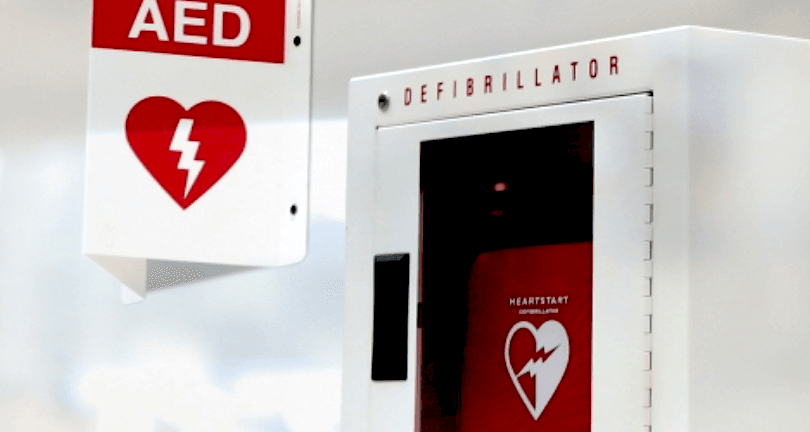
Chances are you’ve seen automated external defibrillators, or AEDs, in public — perhaps in shopping centers, schools or office buildings. You might know their basic purpose: to use an electric shock to get a person’s heart to beat properly again; otherwise, you might feel unsure of how they work, and even frightened by the thought of using one.
You’re not alone. Zapping someone with electricity sounds scary. You might worry you lack the know-how to use one and could harm the person, yourself, or others near you.
The good news is AEDs are remarkable pieces of life-saving technology, designed to be simple and safe for virtually anyone to use on a person in sudden cardiac arrest (SCA).
A key tool in a life-threating emergency
SCA is a life-threatening, common health emergency during which the heart stops beating normally and no longer pumps blood through the body. Oxygen and nutrients don’t reach the brain and other vital organs, and the victim will likely die within minutes without quick intervention.
AEDs serve an important role in the chain of survival for a person in SCA, helping non-medical bystanders – like you – swoop in and bridge the care gap until emergency medical services arrive. (Always call 911 first when helping a person in SCA).
More than 350,000 people in the U.S. suffer an out-of-hospital cardiac arrest each year, and only 8-10% survive. However, research shows the chance of survival increases to 50-74% when an AED is used immediately.
Let’s explore seven basics about AEDs you must know.
1. An AED attempts to restore a heart’s normal rhythm
AEDs are computerized medical devices that analyze what’s happening with a person’s heart during SCA. If the heart is not beating properly, the AED may send one or more electric shocks to restore a normal heartbeat.
An AED includes two adhesive pads that are placed on the victim’s chest and side. The pads are connected to the main AED unit by thin wires that can transmit electric shock.
2. An AED instructs you on how to use it
AEDs use voice prompts, lights, and text-on-screen to guide the user through the steps, including when and where to place the electrode pads, and how to administer a shock(s). Easy-to-follow illustrations help too.
3. An AED will not shock a person who doesn’t need it
The electrode pads you stick on the person’s chest and side send a signal back to the AED computer, which analyzes the person’s heart rhythm to determine whether a shock could help. Only certain types of SCA benefit from a shock. The good news is the most common type, called ventricular fibrillation, is a shockable rhythm.
4. An AED is highly unlikely to shock you or other bystanders
The AED voice commands instruct you to not touch the person while it’s analyzing the heart rhythm or delivering a shock. It will alert you to when it’s safe to touch the person again.
5. An AED can be semi or fully automated
Semi-automated AEDs will tell you to press a button to deliver the electrical shock, while fully automated AEDs will administer the shock without your help.
6. An AED will likely have separate pads for adults and children
Child pads should be used on children between the ages of one and eight. These pads deliver a smaller shock.
7. An AED is used in combination with CPR
Think of CPR and an AED like tag team partners. CPR is typically started before an AED is used. Once the AED delivers a shock or determines one is not needed, CPR should be administered immediately and continued until medical personnel arrive. The AED will instruct you to continue CPR.
More about AEDs
While you don’t need extensive training to use an AED, basic instruction and familiarity with the device can boost your confidence and prepare you to act decisively when it matters most – and potentially save a life.
At Starting Hearts we provide AEDs, as well as training for CPR and AED use, so you’ll be ready to make a life-saving difference.
Contact us for more information: info@startinghearts.org
Leeanne Frazier is a writer based in Texas.
